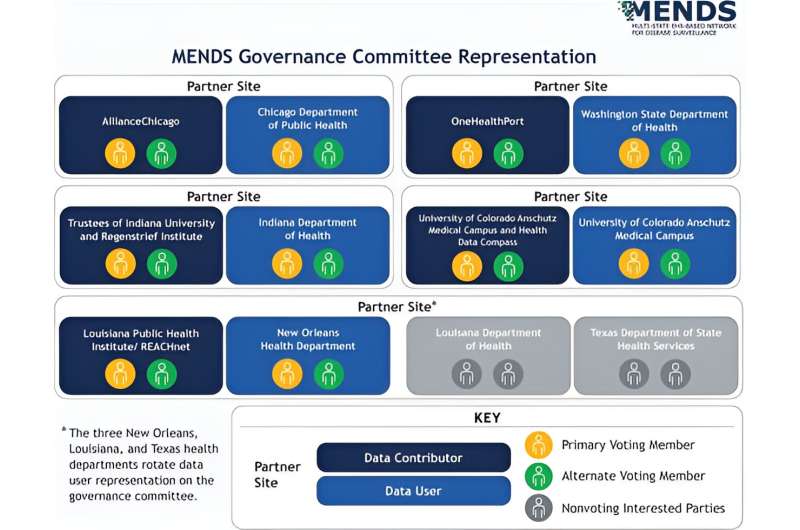This article has been reviewed according to Science X's editorial process and policies. Editors have highlighted the following attributes while ensuring the content's credibility:
fact-checked
trusted source
proofread
Guidance on EHR-based public health surveillance for chronic diseases

As hospitalizations due to chronic conditions increase across the United States, attention is focusing on using data collected in electronic health records (EHRs) by health care systems to enable public health departments to gain an understanding of the incidence and prevalence of hypertension, diabetes, asthma, obesity and other chronic diseases with the ultimate goal of improving disease outcomes.
In the U.S., 90 percent of clinicians, medical laboratories, imaging centers, and other providers use EHR systems, providing ample data on individuals with access to health care. However, access to EHR data by public health departments is limited. Facilitating data sharing with public health departments is complex and requires health data aggregators such as health information exchanges as well as trust among data generators and data users.
A research team including two Regenstrief Institute researchers presents practical guidance for implementing governance for sharing EHR data for chronic disease surveillance based on the experience of the Multi-State EHR-Based Network for Disease Surveillance.
Harnessing the power of health information technology to track infectious diseases has provided vital, in-depth insight to public health departments into infections, hospitalizations, deaths, vaccinations, and more during the COVID-19 pandemic.
Unlike infectious diseases, however, there are no legal requirements that chronic diseases be reported to public health departments. Yet if city, county, and state public health departments could learn about individuals living with chronic conditions from EHR data via a health information exchange or other data-sharing mechanism, they can make a difference in numerous ways, according to the Regenstrief Institute's Center for Biomedical Informatics Interim Director Brian Dixon, Ph.D., MPA, senior author of the paper.
"With data to identify populations, public health agencies could monitor specific geographic areas for increasing or decreasing numbers of cases of a particular disease and drive people living with chronic conditions to a better quality of life and better disease outcomes," Dr. Dixon said.
"For example, if one part of a city or state has an increasing rate of new cases of diabetes perhaps individuals aren't getting the education and care they need. Or if in another section of a city or state there is a moderate amount of hypertension but bad outcomes, maybe they're not taking their medications and need support. Public health department budgets are tight, but they can provide services targeted to chronic diseases.
"I think this paper is very important for policymakers and public health leaders because it specifically outlines the processes and policies that we need to enable this kind of work—which doesn't happen overnight—to occur. Like many things in informatics, the technology exists to aggregate and analyze data on chronic disease. We have the technology to move data from hospital A to a public health department or to aggregate data across multiple years," said Dr. Dixon.
"The barriers are political, legal, and organizational. And so, governance and policy are what you use to address and break down those barriers and work within legal parameters to share data. To sustain this activity, we will need to put this kind of governance and these kinds of policies in place to enable EHR-based chronic disease public health surveillance and intervention to occur everywhere in the U.S."
The current gold standard for chronic disease surveillance is an annual random digit telephone health survey conducted by the U.S. Centers for Disease Control and state health departments. The survey provides reliable metrics about chronic disease in a small but representative sample of the population. However, it takes approximately two years for the data to be available. EHR-based public health surveillance would significantly reduce the delay. Additionally, data would be clinical rather than self-reported.
Dr. Dixon notes that chronic disease surveillance using EHR data requires trust between health care systems and public health departments. Building trust, he says, requires robust intentional governance policies and procedures, as outlined in the paper.
The Multi-State EHR-Based Network for Disease Surveillance is composed of data contributors and health departments representing Texas, New Orleans, Louisiana, Chicago, Washington,comprises and Indiana. The paper reported that the network's governance approach resulted in a transparent governance framework cultivating trust across the network.
"Fostering Governance and Information Partnerships for Chronic Disease Surveillance: The Multi-State EHR-Based Network for Disease Surveillance" is published in Journal of Public Health Management & Practice.
More information: Emily McCormick Kraus et al, Fostering Governance and Information Partnerships for Chronic Disease Surveillance: The Multi-State EHR-Based Network for Disease Surveillance, Journal of Public Health Management and Practice (2023). DOI: 10.1097/PHH.0000000000001810





















